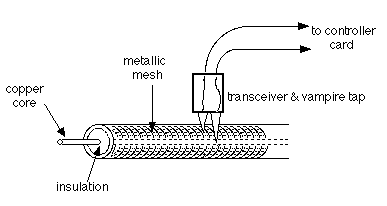Let's turn our attention to local area networks using Ethernet technology for a moment. Ethernet uses a bus based technology, which means that all the computers on the network attach to the same cable, just as components inside a computer itself. Fig. 23.9.1 shows the setup.
How the computer actually attaches to the coax cable is more complicated than just the simple dot shown in Fig. 23.9.2. There is a network controller card as shown in Fig. 23.9.2 that plugs into the main system bus of the computer and is also attached to a cable that plugs into the coax cable. Thus the network is treated just like any other peripheral and device drivers are inserted into the operating system to allow the computer to send and receive streams of bits over the wire.
The cable from the network controller card to the actual network wire plugs into a box called a transceiver (transmitter/receiver). This device has a vampire tap which has several teeth to penetrate the shielding of the coax and make electrical contact with the copper core inside the coax cable. Fig. 23.9.3 shows the vampire tap.

Fig. 23.9.3: Vampire tap of a transceiver in an Ethernet LAN
There are two forms of electrical signaling done in Ethernets: baseband and broadband. We will consider only the baseband. When a computer wishes to send a stream of bits, its transceiver alters the voltage on the wire using the Manchester encoding system. The change in voltage propagates throughout the length of the copper wire at almost the speed of light, spreading outward in both directions from the position of the transceiver. All other transceivers on this Ethernet will pick up these alterations. Since a message put onto the wire is received by everyone else, we say that Ethernets are broadcast networks.
Ethernets are very democratic in their access control mechanism, which determines who gets to use the coax wire and when. Instead of the dictatorial authoritarianism of a bus arbiter, all computers that are attached to an Ethernet can just go ahead and use it. Of course, this could result in chaos if more than one computer, through the electronics of its attached transceiver of course, tries to send bits over the wire. So a technique called CSMA/CD is used by all attached computers.
Here is what CSMA/CD stands for:
CS -- Carrier Sense The attached computers sense (test)
the wire before they begin transmitting
to see if it is already busy.
If so, they wait.
MA -- Multiple Access All computers have equal access to the
wire. There is no hierarchy or arbiter.
CD -- Collision Detect If two computers send at the same time
they will detect a collision of their
respective packets.
Collision detection is perhaps a bit mysterious. First, why would two computers both transmit at the same time if they had first listened to the wire to discover that no one is currently transmitted?
It is possible that two computers might begin transmitting their packets at exactly the same time, even though they had both first listened respectfully and (correctly) ascertained that there were no packets on the wire. It is also possible that the two senders started within a very short time of each other and the second didn't have time to detect the first bit of the first sender on the wire before it started transmitting.
After all, the speed of light, though very great, is finite and these wires can be up to about 1500 meters long. Light travels about 300,000 kilometers/sec in a vacuum (186252 miles/sec) although it travels only about 50% or 75% of that in copper due to resistance of the electrons. Dividing 1500 meters by 300,000,000 meters/sec we get 0.000005 sec, which is an incredibly long 5 microseconds. That means that if the signals traveled at their maximum rate possible and two computers were their furthest distance apart on the wire (1500 meters), there would be a lapse of 5 microseconds from the time that one computer began signaling and the other detected it.
Thus, if they decided independently to start and it just so happened that this occurred within a timeframe of 5 microseconds or less, they would interfere.
When two computers interfere in this way, we say a collision occurs. Collisions can be detected because the voltage levels will be higher than they should be. Whenever two computers both try to signal a 1 with a high voltage, the combined resulting voltage will be the sum of the two 1's, which is out of the acceptable range. Tranceivers are equipped to detect collisions and signal their attached computers that a collision has occurred.
After two computers collide by trying to use the coax cable at the same time, they both stop transmitting and wait a random amount of time before beginning the whole process of sensing the wire and starting to transmit again. Any other transceiver that hears a garbled packet on the coax, one that resulted from a collision, ignores it and doesn't trouble its attached computer. Of course, both of the would-be senders might collide again, although this is made suitably unlikely by waiting a random interval of time that gets wider as more and more collisions occur.
Fig. 23.9.4 shows a pictorial representation of a collision between senders.
Yet when many of the attached computers are trying to transmit on the same Ethernet, the number of collisions may rise exponentially to the point where no one is able to transmit useful data over the LAN. In this case, we say the LAN is saturated. Ethernets are prone to saturation, especially when there are many attached computers and they are constantly using it. Another LAN technology, token ring, does not have this problem.